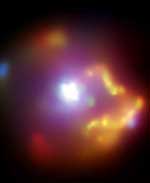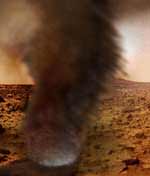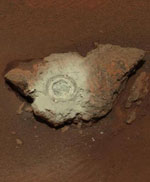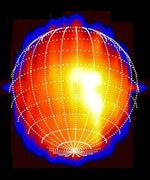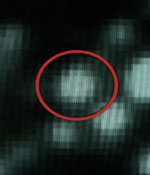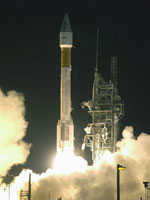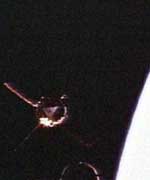
Image credit: NASA
The NASA space vehicle designed to test two important predictions of Albert Einstein’s Theory of General Relativity launched today from Vandenberg Air Force Base, Calif., aboard a Boeing Delta II expendable launch vehicle.
The spacecraft is being inserted into an almost perfect circular polar orbit around the Earth at an altitude of 400 statute miles. “The solar arrays are deployed, and we have received initial data that indicates all systems are operating smoothly. We are very pleased,” said Gravity Probe B (GP-B) program manager Rex Geveden of NASA’s Marshall Space Flight Center (MSFC), Huntsville, Ala. “The Gravity Probe B space vehicle houses one of the most challenging science instruments ever devised and seeks to answer some of the most important questions about the structure of our universe,” he said.
The GP-B mission will use four ultra-precise gyroscopes to test Einstein’s theory that space and time are distorted by the presence of massive objects. To accomplish this, the mission will measure two factors, how space and time are very slightly warped by the presence of the Earth, and how the Earth’s rotation very slightly drags space-time around with it.
“This is a great moment and a great responsibility, the outcome of a unique collaboration of physicists and engineers to develop this near-perfect instrument to test Einstein’s theory of gravity,” said the experiment’s principal investigator Dr. Francis Everitt of Stanford University in Stanford, Calif. “We are very grateful for all the support we have received at NASA and elsewhere for this exacting effort, truly a new venture in fundamental physics.”
In-orbit checkout and calibration is scheduled to last 60 days, followed by a 12-month science-data acquisition period and a two-month post-science period for calibrations.
During the mission, data from GP-B will be received a minimum of twice daily. Either Earth-based ground stations or NASA’s data relay satellites can receive the information. Controllers will be able to communicate with the orbiting space vehicle from the Mission Operations Center at Stanford University.
Data will include space vehicle and instrument performance, as well as the very precise measurements of the gyroscopes’ spin-axis pointing. By 2005 the GP-B mission will be complete. A one-year period is planned for scientific analysis of the data.
MSFC manages the GP-B program. NASA’s prime contractor for the mission, Stanford University, conceived the experiment and is responsible for the design and integration of the science instrument, as well as for mission operations and data analysis. Lockheed Martin, a major subcontractor, designed, integrated and tested the space vehicle and some of its major payload components. NASA’s Kennedy Space Center and Boeing Expendable Launch Systems were responsible for the pre-launch preparations, countdown and launch of the Delta II.
For information about NASA and agency missions on the Internet, visit:
For information about the GP-B mission on the Internet, visit:
http://einstein.stanford.edu/ and http://www.gravityprobeb.com
Original Source: NASA News Release

